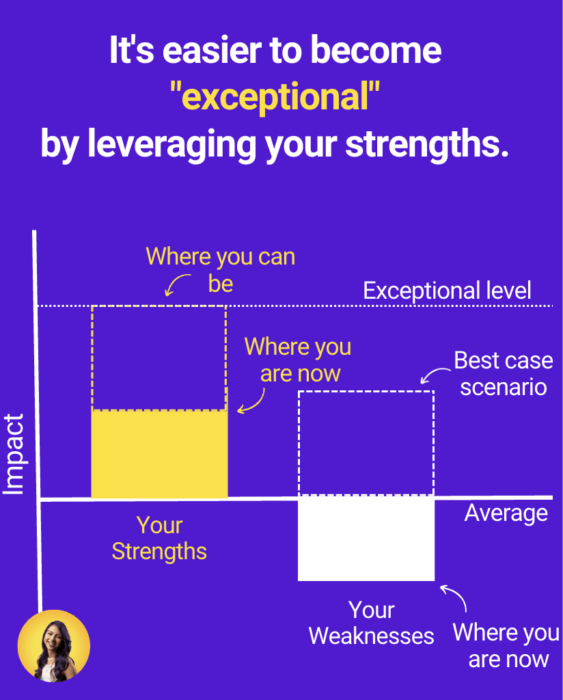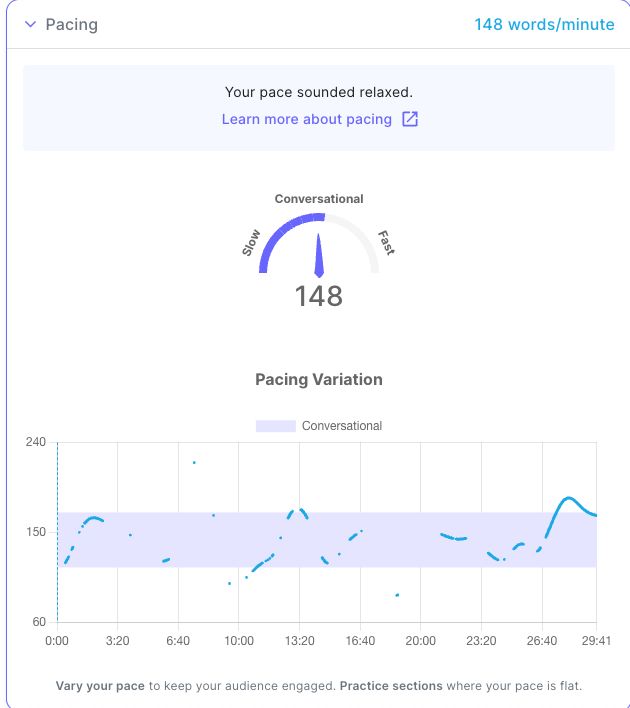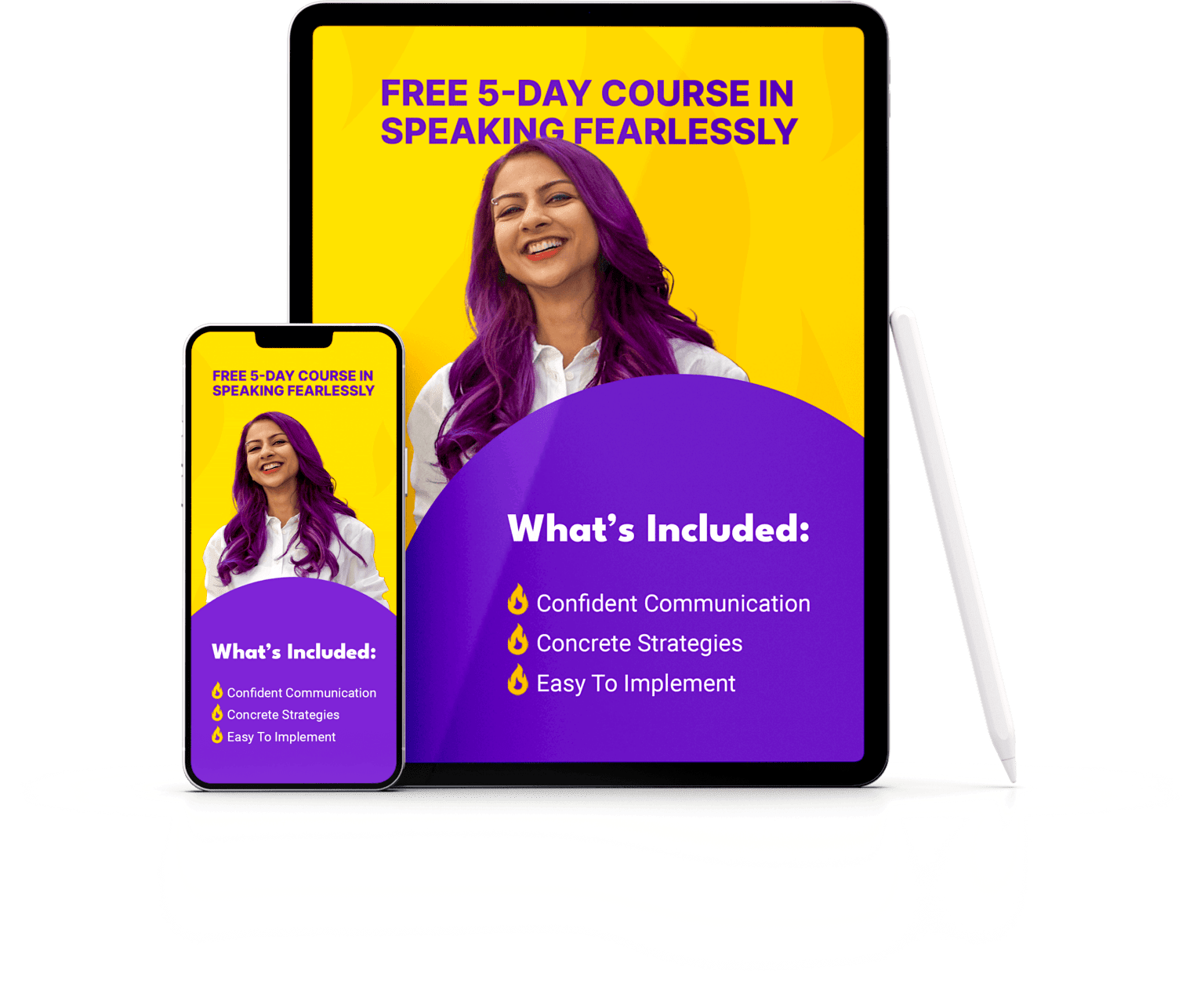Here’s How You Can Find Out How Good Your Public Speaking Skills Are:
Sarah stood up to present in front of a room of investors, feeling butterflies in her stomach.
Her carefully crafted pitch deck beamed on the projector screen, and a wave of doubt washed over her. She didn’t get enough time to prep because she stayed up all night working on her pitch deck.
As she stumbled through her opening lines, Sarah’s voice trembled. Though her idea was innovative and potentially game-changing, its impact was lost because of her poor presentation skills. The investor’s faces remained unreadable, their polite smiles betraying a growing disinterest.
As Sarah somehow completed her presentation and retreated to her desk, she knew the presentation wasn’t as amazing as she’d imagined in her head. Her inability to articulate her idea with clarity and confidence might have cost her the opportunity.

This wasn’t the first time Sarah had faced such a setback. She wasn’t sure how to find what was lacking in her skills and how to improve on it.
That’s when she approached me for coaching.
Sarah and I worked together refining and strengthening her speaking skills. After a few months she started pitching again and secured interest from several investors in her company within a few weeks!
Sarah’s story is not unique. Chances are, you struggle with similar challenges. A lot of people know they can do better when they present in front of an audience – but don’t know where to start.
My experience of coaching Sarah and hundreds of other execs and entrepreneur clients made me write this article – to help people like you.
By the end of this article, you will be able to find out exactly how good your speaking skills are, where the gaps are, and how you can plug them.
What’s inside this article:
Why your speaking skills matter
Most of us underestimate the power of our speaking skills.
We may think it’s just about public speaking, but in reality, effective communication helps us in every aspect of our lives. From conveying our ideas effectively to building relationships, strong speaking skills are critical for our success:
- In your career – it can help you land your dream job, negotiate a raise, or lead your team effectively.
- In your business – it can help with pitching to investors, getting your proposal accepted by the board or engaging with clients.
- Your speaking ability helps build credibility. Your ability to articulate yourself clearly and confidently establishes your expertise, which inspires trust.
- Great communication allows you to express yourself authentically and cultivate deeper connections.
- Research shows that speaking well stimulates creativity. Your ability to speak well can help you explore new ideas and perspectives.

Image by benzoix on Freepik
However, here’s something you must consider.
A lot of people think they have good speaking skills but they’re stuck at average – or worse, they’re way less impactful than they think they are when they speak in public.
Having coached over 300+ presenters over the years, I have seen my clients face these scenarios:
- They project nervousness and lack clarity while speaking, which undermines their credibility and professionalism.
- They ruin their first impressions through poor introductions. This impacts their ability to form a connection with clients, team, or potential investors.
- Weak communication skills make them miss out on important deals, botch pitches, and even sour critical relationships.
This is why…
Identifying gaps in your speaking skills is crucial
You need to evaluate your speaking skills and identify the gaps you need to plug in.

(Source)
What type of presenter are you?
It’s useful to know what kind of presenter you are so that you can get to know your speaking style better.
1. The Beginner Presenter

(Source)
This person is quite nervous and lacks clarity when they present.
They lack engagement with their monotonous voices, delivering low-impact and forgettable content.
You’ll see them reading their slides rather than diving deep into the concepts or ideas. They don’t enjoy delivering the presentation, and their audiences don’t enjoy sitting through it. They main thought during the presentation is “I have to get it over with”.
2. The Average Presenter
These are people with growing expertise in their fields. They do a good job putting together information on their slides but they never focus on their delivery.
They have basic communication skills, but they lack the spark to truly captivate the audience and make an impact. They often don’t make the most of their public speaking opportunities.

Image by wavebreakmedia_micro on Freepik
Being in the audience you may enjoy a part of their presentations (their slides look nice!), but you can make out that they don’t know their material well enough and haven’t practiced it.
They may resort to reading their slides, forgetting what’s on the next slide and using way too many filler words in between articulating thoughts.
These are presenters who may have improved their presentation skills over time and hit a plateau. But the problem is: they don’t realize it.
This lack of realization can impact their effectiveness when they speak – and they aren’t even aware of how much more impact they can make if they refined their speaking skills.
3. The Master Presenter
This is someone who has mastered their communication and presentation style.

(Source)
They captivate you with inspiring content, creating a lasting impression. When the presentation is over, you are left wanting more.
I’m sure you’ve watched at least a few of them. They are celebrated TED speakers, successful entrepreneurs, business leaders, and renowned motivational speakers.
Have you watched Simon Sinek’s ‘How Great Leaders Inspire Action’, or Brené Brown’s TED talk ‘The Power of Vulnerability’? Then you know who we’re talking about.
Which one of these 3 types of speakers are you?
If you feel you’re in one of the first two categories, this article will show you how to move towards the third category. If you’re already in the third category, this article may still help you unearth any gaps that you may have.
Let me share with you the 5-step process I use to help my coaching clients identify the gaps in their public speaking skills and plug them.
My 5-step process to analyze and improve your speaking skills
Step 1. Record yourself
This may seem like a scary thing to do. Recording yourself can make you self-conscious and watching it can be cringey. But this is a foundational step.

(Source)
Every athlete reviews their game footage to analyze their strengths and opportunities. That’s exactly what you’re doing here.
Record yourself speaking about a familiar topic for two minutes. Timing yourself helps you be concise.
Be comfortable knowing that you don’t need to share this with anyone. This is just for you to rewatch and analyze.
A bonus first step: You can also start recording the presentations, pitches or talks, or speeches you’re doing in front of a live audience to watch later.
Step 2. Analyze your performance

(Source)
Watch your recording with a critical eye. The idea is not to critique yourself but to understand your strengths as well as where you can improve. You want to focus on two distinct areas:
Your content:
- Clarity: Was your message clear and concise, or did you use jargon or unclear phrases?
- Conciseness: Did you stay on point and avoid unnecessary fillers or digressions?
- Impact: Did you use examples that stood out? Did you incorporate storytelling?
Delivery:
- Voice: Did you speak with a strong, clear voice? Did you vary your tone and enunciate to keep your audience engaged?
- Pauses: Did you use enough pauses or were you out of breath by the time you were done?
- Pacing: Did you speak too fast?
- Energy: Did you project energy when you spoke? What was your energy level as you started and ended the video?
- Body language: Was your posture confident and open? Did you use gestures effectively to emphasize your points? Did you make eye contact with the camera? Did you vary your expressions or have a poker face throughout?
Make a note of all these elements for each of your recorded exercises.
Step 3. Choose your focus areas
Now you have the data to mine gold! Create these two lists based on your analysis –
Your Strengths:
Always start with what you’re already good at. This surprises my clients. When I ask them to analyze how they did, they tend to start with what they did wrong.
While it’s important to work on opportunity areas, it is equally – or perhaps even more crucial to improve at things you’re already good at..
The truth is – if you focus on your strengths, it’s much easier to achieve elite, exceptional status in terms of your impact. The distance between you and exceptional levels is shorter if you’re already good at a skill.

For instance, if you discover that integrating a story in your presentation is your strength – work on it. With a good story narrated exceptionally well, you can leave a lasting impression on your audience.
Opportunity areas:
Which areas require improvement to maximize your impact?
Make a note of these. These elements need additional focus during your future practice sessions, so you can improve on them when you make your next presentation, pitch an idea, or address your team or organization.
The key is to not practice blindly. This analysis will help you define a clear strategy so that you can set specific goals the next time you practice for a talk or a presentation.
Step 4. Take action
With the strengths and opportunity areas discovered and action items identified, now it’s time to incorporate them in your practice sessions, and then in real-life speaking opportunities.

(Source)
Here are a few critical speaking skills that any strong speaker should have – feel free to select the strategies for the focus areas you might need to improve on:
Enunciation:
If you found that you were mumbling, aim to speak clearly, enunciating every word. If you realized that you used too many filler words, aim to identify which ones you tend to use and where, and then pause instead. Aim to avoid repeating weak words such as “like” and “you know”.
Emphasize important words so they enhance the meaning of the sentence and draw your audience’s attention towards them.
Body language:
If you’re speaking in person, stand tall with your shoulders back and head held high. Keep your bottom half firmly planted on the ground with your top half dynamic. Your posture shows your confidence and in turn, enhances your internal confidence.
On camera – ensure that you’re framing well and that your gestures are visible on the screen. And then – aim to use gestures throughout.
Eye contact:
Make eye contact with your audience – whether it’s in person or on camera to forge a connection and encourage engagement.
Expressions:

(Source)
Use facial expressions to add depth and emotion to your words. A lot of people have their poker faces on – don’t be those people.
Conciseness:
Avoid rambling and get straight to the point. If you are not well prepared, it’s easy to digress and waste time. Keeping a note of important points to cover will help you talk crisp and concisely.
Engaging the audience:
You need to keep the audience engaged to avoid them tuning out. Ask specific questions, use humor, and tell stories to captivate your audience.
You may become self-conscious while doing this. No worries, it happens to the best of us.

(Source)
The trick to deal with it is to turn self-consciousness into self-awareness.
Being self-conscious is about judging yourself – which happens based on how you perceive others to be judging you. However, self-awareness is about being in tune with yourself – by dropping judgment.
Step 5. Create a positive feedback loop
Most of us have negative feedback loops in our heads. We are our own worst critics. We find faults with ourselves -and we remember the worst things that have happened to us.

(Source)
I want you to flip this negative feedback loop.
Arm yourself with strategies and best practices before you need to speak in public. Then, aim to identify what you do well each time you speak – and use it as “proof” for the negative voices that you can do well. Here’s the complete system that I use to build a positive feedback loop:
a) Practice with purpose
Use both the strengths and the areas of improvement that you identified in step #3 to guide your speaking practice and rehearsals.
For example, if you struggle with filler words, practice speaking more deliberately, adding pauses when you feel tempted to use fillers.
If one of your strengths is to enunciate well, then aim to play with your pitch and tones so that you can become an even more captivating speaker.
b) Apply in the real world
Apply the strategies you’re learning to your casual conversations and Zoom meetings. The more data you gather, the better equipped you will be to handle the next speaking opportunity. Don’t wait till you have to deliver a presentation to practice and refine your speaking skills.
c) Debrief with yourself & seek feedback
After every speaking opportunity, take time to reflect.
- What went well?
- Where did you improve?
- What are the areas for further improvement?

Photo by DANIEL INTUS
Make a note on how you felt before, during and after the presentation.
Now, take this feedback into your practice sessions and close the positive feedback loop. This is how you make continuous improvement part of your routine.
You can also take the strengths that you identify as part of this debriefing to show the negative voices in your head – “You’ve done this. You can do it again”.
This is especially helpful for the next time you start feeling nervous before a big presentation.
Seeking feedback is another great way to improve. Ask trusted friends, colleagues, or a coach for their honest feedback on your speaking. This will help you identify blind spots and areas for improvement that you might have missed with your self-analysis.
Bonus: How to use AI to improve your speaking skills
Getting to know yourself as a speaker and analyzing your speech patterns is the best way to improve- and now you can use AI to help too.

(Source)
AI tools can help you understand your level of speaking skills by analyzing your speech patterns for different attributes. You can simply record yourself using an AI app, and it will give you metrics such as:
- What kind of pauses you took, and how many
- How loud you were
- Whether you made eye contact
- Your pacing
- Whether you repeated specific words
- How many filler words you used (“um”, “ah”, “err” etc)
..and more.
These metrics help you get a deeper understanding of your speech mannerisms – which you may not notice in real-time or even while watching yourself back on video. Once you become aware of them, you can work towards avoiding the bad mannerisms and improving the good ones.
It’s possible to use AI in two ways:
- Record yourself speaking through an AI platform, and analyze the metrics (for example, using Yoodli)
- Get live “coaching” and feedback during your calls (for example, using a platform like Poised.com)
(I personally find #2 to be super distracting – but I’ve heard it works well for some people!)
I also AI tools with my clients:

- to get them to analyze their speaking exercises, and
- to help them become more aware of their speech patterns during live events
You get cool data like how loud you were when you spoke. Typically – this is one of the elements that I’ve found people to be less aware of. A number of people either speak too softly or way too loudly – and become news announcers.

The AI measures how many times you’ve repeated certain words. This way you can tell if you’ve either got a pet phrase or if you’re using repetition as a filler while you’re thinking of the next thing to say.

This is my favorite metric – AI can measure your pacing to show you exactly how fast or slow you were when you spoke. This is super helpful because it shows when you may have either gotten too nervous, too stressed out or too excited. The graph shows a nice variation in the pacing (peaks and valleys) – mostly within the blue “conversational” pacing strip.

Conclusion
Mastering the art of speaking well can prep you for success in every aspect of life.
Through this article, we’ve explored the importance of strong communication skills and the gap that often exists between the perception of our own speaking skills and reality.
Effective communication is not just about public speaking – it’s about connecting with others, building relationships, and influencing your audience. By using the 5-step process I shared, you can deeply understand your speaking skills and become a more confident communicator, creating a lasting impact every time you speak.
Becoming a master communicator is a journey, not a destination.
So, take the first step today. Start recording yourself, analyze your strengths and opportunity areas, and use them to build a feedback loop to consistently improve your speaking skills.
Want to work on becoming a more powerful speaker? Let’s talk.



